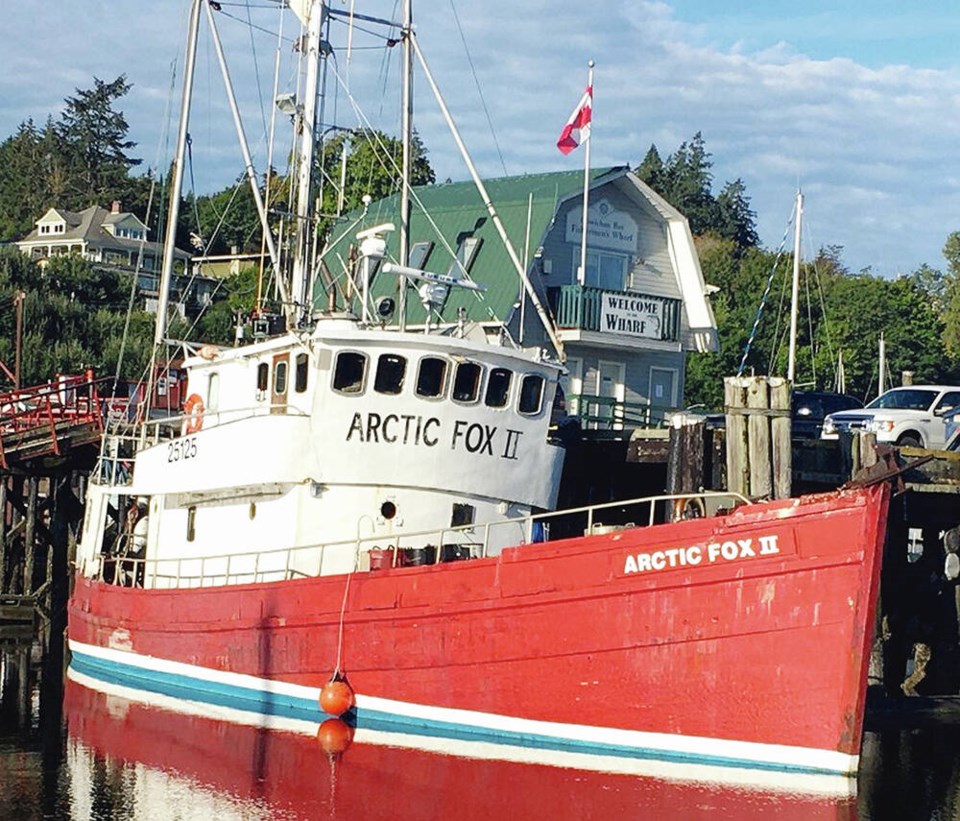Insufficient training and vessel maintenance contributed to the deaths of two crew members aboard a fishing boat that sank in 2020 off Bamfield, according to a Transportation Safety Board investigation that calls for more inspections of such vessels.
The 20-metre Arctic Fox II began sinking on Aug. 11 while fishing for tuna about 77 nautical miles offshore. The boat’s master, identified as Tom Lindberg, 76, of Cobble Hill, and a unnamed deckhand drowned. A lone survivor, also not identified, who made it to a life raft was rescued later by the U.S. Coast Guard.
The TSB said in its report Tuesday that lack of maintenance on the 1947-built vessel and the absence of regulatory surveillance on the boat contributed to Arctic Fox II taking on water in the early-morning hours and eventually sinking.
“This occurrence highlights the need for Transport Canada to provide more surveillance and monitoring to effectively ensure that vessel owners and authorized representatives take ownership of their safety responsibilities and comply with regulatory requirements,” the report said.
The TSB said the master of the fishing vessel held an expired Fishing Master, Fourth Class certificate issued in 2001. New vessel stability education and medical certificates have been required by Transport Canada since 2007, and the master had no formal training on how to properly prepare new crew members in procedures, drills and familiarization, said the report.
The two crew members responded to a job ad for experienced crew members for tuna fishing, but the report said neither had experience.
The Arctic Fox II had sufficient life-saving equipment on board, but the master hadn’t received any new training in nearly two decades, and both crew members had no formal training at all, said the report.
Although the master gave informal instructions on how to don their immersion suits — designed to protect mariners from cold water and provide buoyancy — all were improperly worn when the survivor and deceased were found, noted the report.
The TSB said the master of the vessel and the owner of the Arctic Fox, Teague Fishing Corp., believed that the risks of the fishing operation had been addressed sufficiently, adding the “perceptions of risk were likely influenced by economic incentives, approvals and certificates and many successful voyages.”
But in the early-morning hours, the Arctic Fox reported taking on water. As the skipper attempted to deal with the sinking boat and other safety protocols, he ordered the two crew members to prepare to abandon ship.
The Arctic Fox drifted and rolled as waves landed on the deck.
The report said the skipper and crew were unfamiliar with the instructions for deploying the life raft and, in their efforts to deploy the raft, its painter line was disconnected from the vessel.
Moments later, the skipper and one of the crew members entered the water with their immersion suits only partially zipped and with ankle straps unsecured. They were exposed to the elements and eventually drowned, said the report. The other crew member managed to reach the life raft and survive.
“The familiarization [with] the life-saving equipment that the crew received was insufficient for them to successfully abandon the vessel, and the crew’s response was guided only by their limited experience,” said the TSB investigation.
The Arctic Fox II arrived in Canada in 1977 and was first registered in 1984 when it began fishing operations. It was acquired by Teague Fishing Corp. in 2008, sold and then reacquired in 2018, when it was registered again with Transport Canada. It was issued a tuna licence by the Department of Fisheries and Oceans in June 2020.
However, the TSB said a review of records from Transport Canada showed that while Transport Canada had inspected the vessel in 2004 and 2008, there had been no other inspections of the vessel since.
“[Transport Canada] had neither identified the absence of an inspection in 2018 nor followed up with the [owner] about the fact that the vessel was overdue for an inspection,” the TSB said.
Regulatory surveillance is a key safety issue and on the TSB’s “watchlist.” It notes that one of the gaps in safety measures is that small commercial fishing vessels are required to be registered with the Department of Fisheries and Oceans, but not Transport Canada.
TSB said Transport Canada’s surveillance program is not always effective, and does not address all commercial vessels.
The TSB said many smaller Canadian vessels — those under 15 gross tonnage — “go largely uninspected.” Authorized representatives are responsible for safety. However, many owners or representatives of small vessels have limited awareness of key sections of the Canada Shipping Act, 2001, or of the broader regulatory framework, the TSB said.
The TSB’s report into the sinking of the Sarah Anne off Newfoundland in May 2020 with the loss of all four crew members included a recommendation that calls for the Department of Fisheries and Oceans to require that any Canadian vessel that is used to commercially harvest marine resources have a current and accurate Transport Canada registration.
The Sarah Anne had not been inspected once during its 40 years of service and had been inaccurately registered with Transport Canada. “Accurate registration is the necessary first step in safety oversight,” said the TSB.
Issues on the watchlist are complex and difficult to solve, requiring action from many stakeholders, including operators and the regulator, said the TSB. “Although some steps may have been taken, more needs to be done.”
The TSB said commercial fishing continues to be one of the most dangerous occupations in Canada.
“Every year, the same safety deficiencies on board fishing vessels continue to put at risk the lives of thousands of Canadian commercial fish harvesters,” the TSB said.
“Developing a strong safety culture in the fishing industry is required to foster greater compliance with regulations. Safety is a shared responsibility. Regulators, vessel owners, and fish harvesters each must take ownership of safety to reduce accidents and preventable loss of life.”



